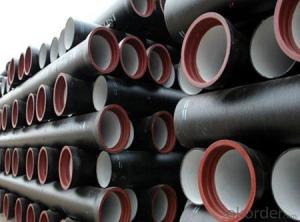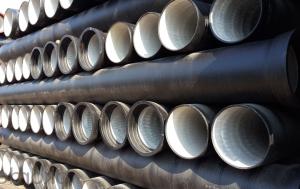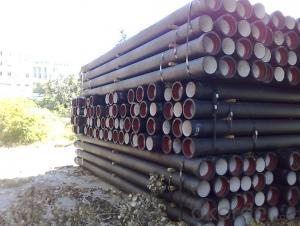Ductile Iron Pipe of China EN545/EN598/ISO2531 DN500
- Loading Port:
- China main port
- Payment Terms:
- TT or LC
- Min Order Qty:
- 25 m.t.
- Supply Capability:
- 200000 m.t./month
OKorder Service Pledge
OKorder Financial Service
You Might Also Like
1,Ductile Iron Pipe Description :
1) Pipes confirm to ISO2531,K9 class,T type joint,6m long,with inside cements lining conform to ISO4179, outside Zinc spraying(130g/m2) and bitumen coating(70μm) conform to ISO8179.
2) Pipe ends: Spigot and socket ends, with 100% SBR rubber gaskets accoding to ISO4633
3) we can do third party inspection according to customer's request.
4) Our products have been sold to many international market, such as Middle East and South East Asia and Africa.
2,Main Features of the Ductile Iron Pipe:
•High yield strength
•High tensile Strength
•High corrosion resistance
•Pressure Resistence
•Anti-corrosion
•Installation is convenient
•Satisfy the highest hygienic standards
3,Ductile Iron Pipe Images:


4. Ductile Iron Pipe Specification
Surface Finishes: Bare, Oiled, Mill Varnish, Galv,FBE, FBE Dual, 3LPE, 3LPP, Coal Tar,Concrete Coating and Tape Wrap
End Finishes: Beveled, Square Cut, Threaded, hat
Additional Services: Internal Coating
Packaging: packed in bag, plastic bag, steel strip, steel wire,double wire, iron box, wooden box, tarpaulin, plastic sheeting
Inspection: MOODY SGS BV GL DNV ABS LIOYD’S
Test: X-ray, UT, magnetic particle,inspection,hydrostatic test.
Processing service: Beveling, Threading, Slotting, Cut-to length, Bends, Quench and Temper, Fabrication, Double-jointing and On-site assistance
Documentary: MTC, material certification,Origin certification, CI or PI,Test Report, export licence, handling order, B/L,insurance policy,shipping instructions, contract, packing list etc.
Internal lining: ductile iron pipes shall have an internal cement mortar lining in acc with ISO4179.
External coating: ductile iron pipes shall be externally coated with metallic zinc spray plus a further layer of resin painting to ISO8179.
Gasket: 100% SBR/NBR/EPDM rubber gasket in accordance with ISO4633.
Payment term: L/C, T/T.
5.FAQ:
We have organized several common questions for our clients,may help you sincerely:
1.Q: Why would you choose ductile iron pipe rather than other pipe materials?
A:The reasons are obvious for that not only ductile iron pipe possesses the inherent strength and flexibility of ductile iron, combined with proven corrosion protection systems, but also the cost savings can be achieved from design to installation and commissioning.
2.Q:Why can you guarantee the inner of pipes can’t be corroded?
A: High alumina cement mortar lining and sulphate-resistant cement mortar lining. These two special linings are applicable to inner anti-corrosion for sewage pipes, improving resistance to erosion of the sewage components.
- Q: How does ductile iron pipe resist internal corrosion?
- Ductile iron pipe resists internal corrosion due to the protective barrier formed by its cement lining. This lining acts as a barrier between the iron pipe and the transported fluid, preventing direct contact and minimizing the chances of corrosion. Additionally, the high carbon content in ductile iron enhances its corrosion resistance compared to other types of iron pipes.
- Q: Can ductile iron pipe be used for industrial applications?
- Yes, ductile iron pipe can be used for industrial applications. Ductile iron pipe is known for its strength, durability, and flexibility, making it suitable for a wide range of industrial settings. It is commonly used for transporting water, wastewater, and other fluids in industrial facilities such as power plants, chemical plants, refineries, and manufacturing plants. Ductile iron pipe is resistant to corrosion, which is important in industrial environments where the pipes may be exposed to chemicals, high temperatures, or abrasive materials. Additionally, its high tensile strength allows it to withstand high-pressure applications, making it ideal for industrial use. Overall, ductile iron pipe is a reliable and cost-effective choice for various industrial applications.
- Q: What is the typical lifespan of ductile iron pipe?
- The typical lifespan of ductile iron pipe can vary depending on various factors such as the quality of the pipe, the conditions it is exposed to, and the maintenance practices employed. However, on average, ductile iron pipe has a lifespan of around 100 years. This is due to its inherent strength and durability, which allows it to withstand high pressure and various environmental conditions. Additionally, ductile iron pipe is often coated with protective materials such as cement mortar lining or polyethylene encasement, further enhancing its longevity. Regular inspections and maintenance can also help extend the lifespan of ductile iron pipe, ensuring that any issues or potential damages are identified and addressed promptly.
- Q: Are ductile iron pipes suitable for use in hydropower projects?
- Yes, ductile iron pipes are suitable for use in hydropower projects. Ductile iron pipes have a high tensile strength and are resistant to corrosion, making them ideal for applications in hydropower projects where water flow and pressure are involved. They are capable of withstanding high pressure and are durable, ensuring long-term reliability and safety in hydropower systems. Additionally, ductile iron pipes are cost-effective compared to other materials like steel, making them a popular choice for hydropower projects. Overall, ductile iron pipes offer the necessary characteristics and performance qualities required for the demanding conditions of hydropower projects.
- Q: What is ductile iron?
- Ductile iron is a type of cast iron that has improved strength and ductility due to its unique microstructure. It is created by adding small amounts of magnesium to molten iron, which causes the graphite in the iron to form in a nodular shape rather than in flakes. This nodular graphite structure gives ductile iron its characteristic properties, making it more resistant to cracking and allowing it to be easily machined and welded. Ductile iron is widely used in various industries for its excellent strength, impact resistance, and durability.
- Q: How can the three pipes of ductile iron leak?
- The raw material used in RE can be installed in the thread, can also be used on the same thread AB, re install is also available, but it is hard to remove.
- Q: Why is the cast iron tube lined with cement? Under what circumstances are ductile iron pipes lined with cement, and under what circumstances do not have to be lined with cement?
- Cement lining to protect water quality, reduce loss, improve the service life of the pipeline ductile, ductile iron pipes are generally lined, which the en545 standard specifies the quality of what kind of what kind of cement.
- Q: How are ductile iron pipes protected during transportation and storage?
- Ductile iron pipes are protected during transportation and storage through various methods to ensure their integrity and prevent any potential damage. Firstly, these pipes are typically coated with a protective layer, such as epoxy or zinc, which acts as a barrier against corrosion. This coating helps to safeguard the pipes from moisture and other corrosive elements during transit and storage. Additionally, ductile iron pipes are often bundled together and secured with straps or bands to prevent any movement or shifting that could lead to mechanical damage. This bundling also makes it easier to handle and transport the pipes in a more organized manner. During transportation, the pipes are usually loaded onto pallets or placed in crates to provide added protection and stability. This helps to minimize the risk of any accidental impact or rough handling that could potentially cause cracks or fractures. Furthermore, proper labeling and marking of the pipes is essential to ensure that they are handled appropriately. This includes displaying handling instructions, weight limits, and pipe specifications, which helps prevent mishandling and damage during transportation. Moreover, storage conditions are crucial to maintaining the integrity of ductile iron pipes. They should be stored in a clean, dry, and well-ventilated area to prevent exposure to moisture and humidity. Pipes should be kept away from direct sunlight and extreme temperatures to avoid any potential degradation of the protective coating. In conclusion, protecting ductile iron pipes during transportation and storage involves applying protective coatings, bundling and securing them, utilizing appropriate packaging materials, ensuring proper handling and labeling, and storing them in suitable conditions. These measures aim to maintain the quality and structural integrity of the pipes, ensuring they arrive at their destination in optimal condition.
- Q: Can ductile iron pipes be used for underground chemical transport systems?
- No, ductile iron pipes are not suitable for underground chemical transport systems as they are prone to corrosion and may react with certain chemicals, leading to potential leaks and contamination.
- Q: Are ductile iron pipes resistant to freeze-thaw cycles?
- Yes, ductile iron pipes are resistant to freeze-thaw cycles. Ductile iron is a type of cast iron that has been treated with magnesium, which improves its strength, durability, and resistance to cracking. This enhanced material properties make ductile iron pipes highly resistant to the expansion and contraction that occurs during freeze-thaw cycles. Unlike other materials such as PVC or concrete, which may crack or break under the pressure caused by freezing water, ductile iron pipes have the ability to withstand these cycles without sustaining any significant damage. Additionally, ductile iron pipes have a smooth interior surface that prevents the formation of ice or frost buildup, further enhancing their resistance to freeze-thaw cycles. Overall, ductile iron pipes are an excellent choice for water distribution systems in regions with cold climates, as they offer superior resistance to the effects of freezing and thawing.
Send your message to us
Ductile Iron Pipe of China EN545/EN598/ISO2531 DN500
- Loading Port:
- China main port
- Payment Terms:
- TT or LC
- Min Order Qty:
- 25 m.t.
- Supply Capability:
- 200000 m.t./month
OKorder Service Pledge
OKorder Financial Service
Similar products
Hot products
Hot Searches
Related keywords



























